Leadership Management: Styles, Challenges, and Future Trends
VerifiedAdded on 2022/08/17
|6
|2302
|11
Essay
AI Summary
This essay provides a comprehensive overview of leadership management, exploring various contemporary leadership styles such as charismatic, transformational, servant, transactional, and bossless leadership with self-managed teams. It delves into the characteristics of effective leaders, including traits like decisiveness and accountability. The paper examines the rise of self-managed teams, their benefits (cost reduction, innovation) and the drivers behind their adoption (technology, competition). It discusses relevant leadership theories, including Blanchard's situational leadership, and explores different leadership roles within self-managed teams: envisioning, organizing, spanning, and social leadership. The essay also addresses the challenges and characteristics of bossless leadership, including consent and mandate, decoupling from position, and servant leadership. The paper concludes by emphasizing the potential of bossless leadership as a future organizational model to boost innovation and competitiveness, while also acknowledging the availability of alternative democratic management approaches.
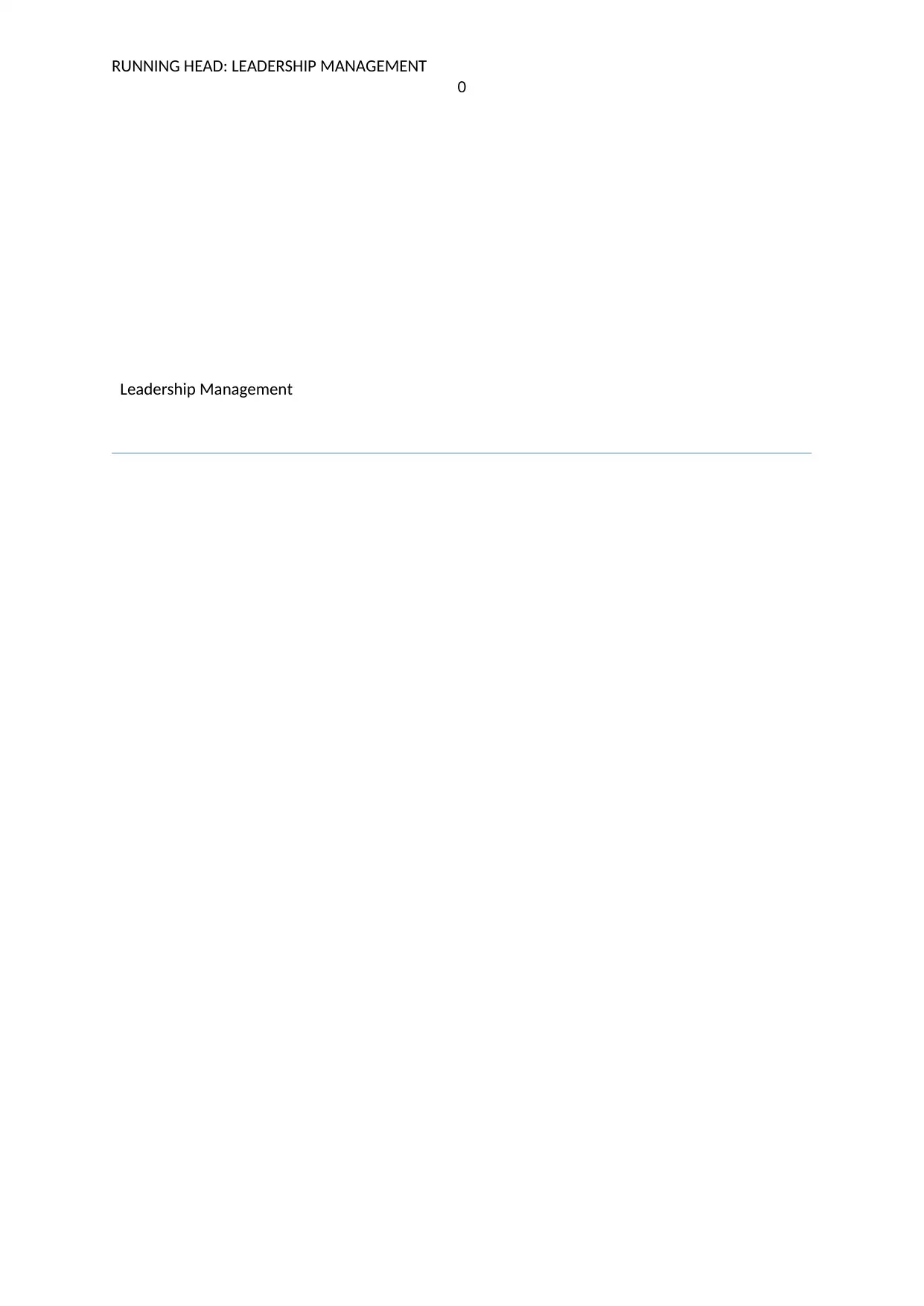
RUNNING HEAD: LEADERSHIP MANAGEMENT
0
Leadership Management
0
Leadership Management
Paraphrase This Document
Need a fresh take? Get an instant paraphrase of this document with our AI Paraphraser
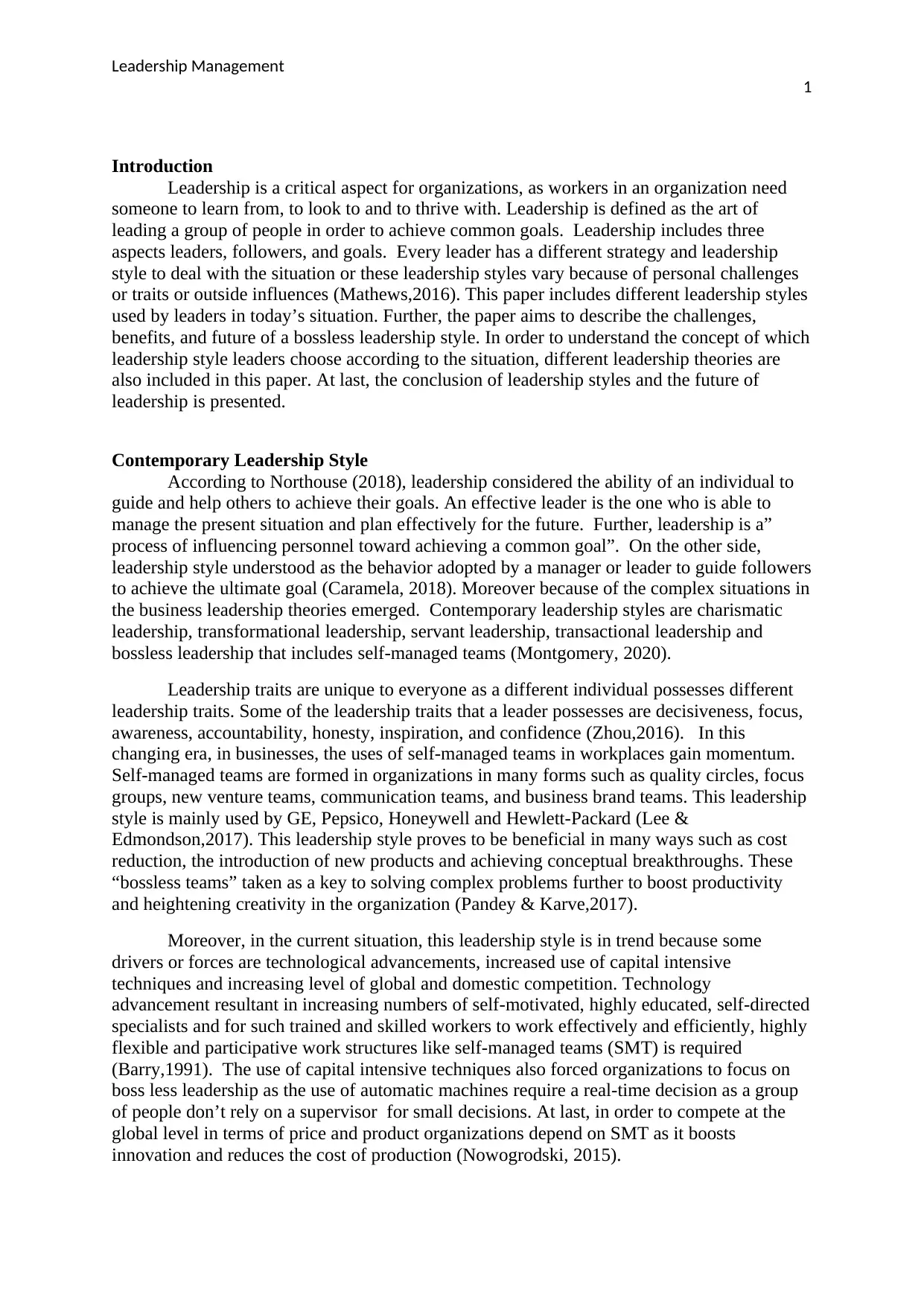
Leadership Management
1
Introduction
Leadership is a critical aspect for organizations, as workers in an organization need
someone to learn from, to look to and to thrive with. Leadership is defined as the art of
leading a group of people in order to achieve common goals. Leadership includes three
aspects leaders, followers, and goals. Every leader has a different strategy and leadership
style to deal with the situation or these leadership styles vary because of personal challenges
or traits or outside influences (Mathews,2016). This paper includes different leadership styles
used by leaders in today’s situation. Further, the paper aims to describe the challenges,
benefits, and future of a bossless leadership style. In order to understand the concept of which
leadership style leaders choose according to the situation, different leadership theories are
also included in this paper. At last, the conclusion of leadership styles and the future of
leadership is presented.
Contemporary Leadership Style
According to Northouse (2018), leadership considered the ability of an individual to
guide and help others to achieve their goals. An effective leader is the one who is able to
manage the present situation and plan effectively for the future. Further, leadership is a”
process of influencing personnel toward achieving a common goal”. On the other side,
leadership style understood as the behavior adopted by a manager or leader to guide followers
to achieve the ultimate goal (Caramela, 2018). Moreover because of the complex situations in
the business leadership theories emerged. Contemporary leadership styles are charismatic
leadership, transformational leadership, servant leadership, transactional leadership and
bossless leadership that includes self-managed teams (Montgomery, 2020).
Leadership traits are unique to everyone as a different individual possesses different
leadership traits. Some of the leadership traits that a leader possesses are decisiveness, focus,
awareness, accountability, honesty, inspiration, and confidence (Zhou,2016). In this
changing era, in businesses, the uses of self-managed teams in workplaces gain momentum.
Self-managed teams are formed in organizations in many forms such as quality circles, focus
groups, new venture teams, communication teams, and business brand teams. This leadership
style is mainly used by GE, Pepsico, Honeywell and Hewlett-Packard (Lee &
Edmondson,2017). This leadership style proves to be beneficial in many ways such as cost
reduction, the introduction of new products and achieving conceptual breakthroughs. These
“bossless teams” taken as a key to solving complex problems further to boost productivity
and heightening creativity in the organization (Pandey & Karve,2017).
Moreover, in the current situation, this leadership style is in trend because some
drivers or forces are technological advancements, increased use of capital intensive
techniques and increasing level of global and domestic competition. Technology
advancement resultant in increasing numbers of self-motivated, highly educated, self-directed
specialists and for such trained and skilled workers to work effectively and efficiently, highly
flexible and participative work structures like self-managed teams (SMT) is required
(Barry,1991). The use of capital intensive techniques also forced organizations to focus on
boss less leadership as the use of automatic machines require a real-time decision as a group
of people don’t rely on a supervisor for small decisions. At last, in order to compete at the
global level in terms of price and product organizations depend on SMT as it boosts
innovation and reduces the cost of production (Nowogrodski, 2015).
1
Introduction
Leadership is a critical aspect for organizations, as workers in an organization need
someone to learn from, to look to and to thrive with. Leadership is defined as the art of
leading a group of people in order to achieve common goals. Leadership includes three
aspects leaders, followers, and goals. Every leader has a different strategy and leadership
style to deal with the situation or these leadership styles vary because of personal challenges
or traits or outside influences (Mathews,2016). This paper includes different leadership styles
used by leaders in today’s situation. Further, the paper aims to describe the challenges,
benefits, and future of a bossless leadership style. In order to understand the concept of which
leadership style leaders choose according to the situation, different leadership theories are
also included in this paper. At last, the conclusion of leadership styles and the future of
leadership is presented.
Contemporary Leadership Style
According to Northouse (2018), leadership considered the ability of an individual to
guide and help others to achieve their goals. An effective leader is the one who is able to
manage the present situation and plan effectively for the future. Further, leadership is a”
process of influencing personnel toward achieving a common goal”. On the other side,
leadership style understood as the behavior adopted by a manager or leader to guide followers
to achieve the ultimate goal (Caramela, 2018). Moreover because of the complex situations in
the business leadership theories emerged. Contemporary leadership styles are charismatic
leadership, transformational leadership, servant leadership, transactional leadership and
bossless leadership that includes self-managed teams (Montgomery, 2020).
Leadership traits are unique to everyone as a different individual possesses different
leadership traits. Some of the leadership traits that a leader possesses are decisiveness, focus,
awareness, accountability, honesty, inspiration, and confidence (Zhou,2016). In this
changing era, in businesses, the uses of self-managed teams in workplaces gain momentum.
Self-managed teams are formed in organizations in many forms such as quality circles, focus
groups, new venture teams, communication teams, and business brand teams. This leadership
style is mainly used by GE, Pepsico, Honeywell and Hewlett-Packard (Lee &
Edmondson,2017). This leadership style proves to be beneficial in many ways such as cost
reduction, the introduction of new products and achieving conceptual breakthroughs. These
“bossless teams” taken as a key to solving complex problems further to boost productivity
and heightening creativity in the organization (Pandey & Karve,2017).
Moreover, in the current situation, this leadership style is in trend because some
drivers or forces are technological advancements, increased use of capital intensive
techniques and increasing level of global and domestic competition. Technology
advancement resultant in increasing numbers of self-motivated, highly educated, self-directed
specialists and for such trained and skilled workers to work effectively and efficiently, highly
flexible and participative work structures like self-managed teams (SMT) is required
(Barry,1991). The use of capital intensive techniques also forced organizations to focus on
boss less leadership as the use of automatic machines require a real-time decision as a group
of people don’t rely on a supervisor for small decisions. At last, in order to compete at the
global level in terms of price and product organizations depend on SMT as it boosts
innovation and reduces the cost of production (Nowogrodski, 2015).
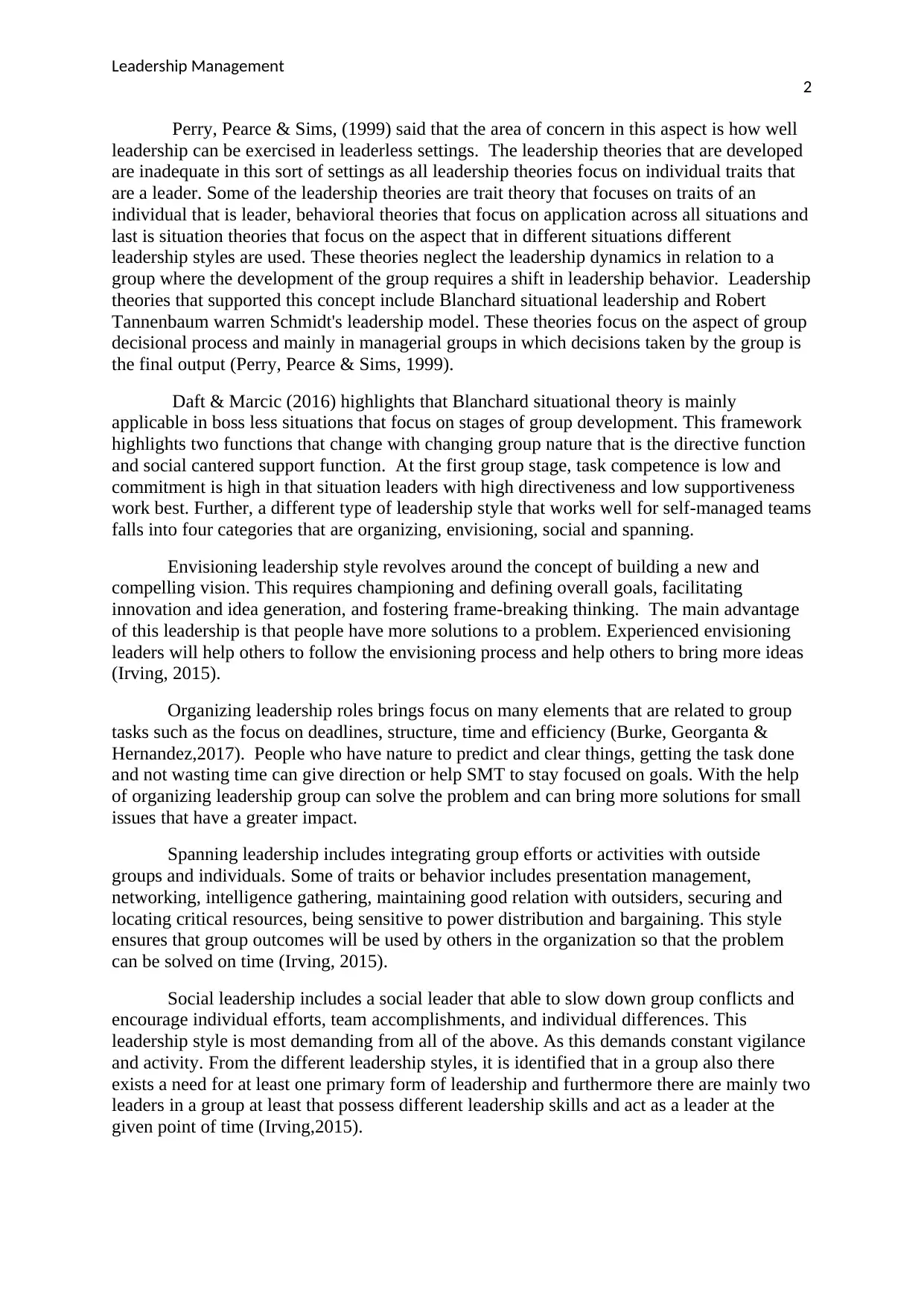
Leadership Management
2
Perry, Pearce & Sims, (1999) said that the area of concern in this aspect is how well
leadership can be exercised in leaderless settings. The leadership theories that are developed
are inadequate in this sort of settings as all leadership theories focus on individual traits that
are a leader. Some of the leadership theories are trait theory that focuses on traits of an
individual that is leader, behavioral theories that focus on application across all situations and
last is situation theories that focus on the aspect that in different situations different
leadership styles are used. These theories neglect the leadership dynamics in relation to a
group where the development of the group requires a shift in leadership behavior. Leadership
theories that supported this concept include Blanchard situational leadership and Robert
Tannenbaum warren Schmidt's leadership model. These theories focus on the aspect of group
decisional process and mainly in managerial groups in which decisions taken by the group is
the final output (Perry, Pearce & Sims, 1999).
Daft & Marcic (2016) highlights that Blanchard situational theory is mainly
applicable in boss less situations that focus on stages of group development. This framework
highlights two functions that change with changing group nature that is the directive function
and social cantered support function. At the first group stage, task competence is low and
commitment is high in that situation leaders with high directiveness and low supportiveness
work best. Further, a different type of leadership style that works well for self-managed teams
falls into four categories that are organizing, envisioning, social and spanning.
Envisioning leadership style revolves around the concept of building a new and
compelling vision. This requires championing and defining overall goals, facilitating
innovation and idea generation, and fostering frame-breaking thinking. The main advantage
of this leadership is that people have more solutions to a problem. Experienced envisioning
leaders will help others to follow the envisioning process and help others to bring more ideas
(Irving, 2015).
Organizing leadership roles brings focus on many elements that are related to group
tasks such as the focus on deadlines, structure, time and efficiency (Burke, Georganta &
Hernandez,2017). People who have nature to predict and clear things, getting the task done
and not wasting time can give direction or help SMT to stay focused on goals. With the help
of organizing leadership group can solve the problem and can bring more solutions for small
issues that have a greater impact.
Spanning leadership includes integrating group efforts or activities with outside
groups and individuals. Some of traits or behavior includes presentation management,
networking, intelligence gathering, maintaining good relation with outsiders, securing and
locating critical resources, being sensitive to power distribution and bargaining. This style
ensures that group outcomes will be used by others in the organization so that the problem
can be solved on time (Irving, 2015).
Social leadership includes a social leader that able to slow down group conflicts and
encourage individual efforts, team accomplishments, and individual differences. This
leadership style is most demanding from all of the above. As this demands constant vigilance
and activity. From the different leadership styles, it is identified that in a group also there
exists a need for at least one primary form of leadership and furthermore there are mainly two
leaders in a group at least that possess different leadership skills and act as a leader at the
given point of time (Irving,2015).
2
Perry, Pearce & Sims, (1999) said that the area of concern in this aspect is how well
leadership can be exercised in leaderless settings. The leadership theories that are developed
are inadequate in this sort of settings as all leadership theories focus on individual traits that
are a leader. Some of the leadership theories are trait theory that focuses on traits of an
individual that is leader, behavioral theories that focus on application across all situations and
last is situation theories that focus on the aspect that in different situations different
leadership styles are used. These theories neglect the leadership dynamics in relation to a
group where the development of the group requires a shift in leadership behavior. Leadership
theories that supported this concept include Blanchard situational leadership and Robert
Tannenbaum warren Schmidt's leadership model. These theories focus on the aspect of group
decisional process and mainly in managerial groups in which decisions taken by the group is
the final output (Perry, Pearce & Sims, 1999).
Daft & Marcic (2016) highlights that Blanchard situational theory is mainly
applicable in boss less situations that focus on stages of group development. This framework
highlights two functions that change with changing group nature that is the directive function
and social cantered support function. At the first group stage, task competence is low and
commitment is high in that situation leaders with high directiveness and low supportiveness
work best. Further, a different type of leadership style that works well for self-managed teams
falls into four categories that are organizing, envisioning, social and spanning.
Envisioning leadership style revolves around the concept of building a new and
compelling vision. This requires championing and defining overall goals, facilitating
innovation and idea generation, and fostering frame-breaking thinking. The main advantage
of this leadership is that people have more solutions to a problem. Experienced envisioning
leaders will help others to follow the envisioning process and help others to bring more ideas
(Irving, 2015).
Organizing leadership roles brings focus on many elements that are related to group
tasks such as the focus on deadlines, structure, time and efficiency (Burke, Georganta &
Hernandez,2017). People who have nature to predict and clear things, getting the task done
and not wasting time can give direction or help SMT to stay focused on goals. With the help
of organizing leadership group can solve the problem and can bring more solutions for small
issues that have a greater impact.
Spanning leadership includes integrating group efforts or activities with outside
groups and individuals. Some of traits or behavior includes presentation management,
networking, intelligence gathering, maintaining good relation with outsiders, securing and
locating critical resources, being sensitive to power distribution and bargaining. This style
ensures that group outcomes will be used by others in the organization so that the problem
can be solved on time (Irving, 2015).
Social leadership includes a social leader that able to slow down group conflicts and
encourage individual efforts, team accomplishments, and individual differences. This
leadership style is most demanding from all of the above. As this demands constant vigilance
and activity. From the different leadership styles, it is identified that in a group also there
exists a need for at least one primary form of leadership and furthermore there are mainly two
leaders in a group at least that possess different leadership skills and act as a leader at the
given point of time (Irving,2015).
⊘ This is a preview!⊘
Do you want full access?
Subscribe today to unlock all pages.

Trusted by 1+ million students worldwide
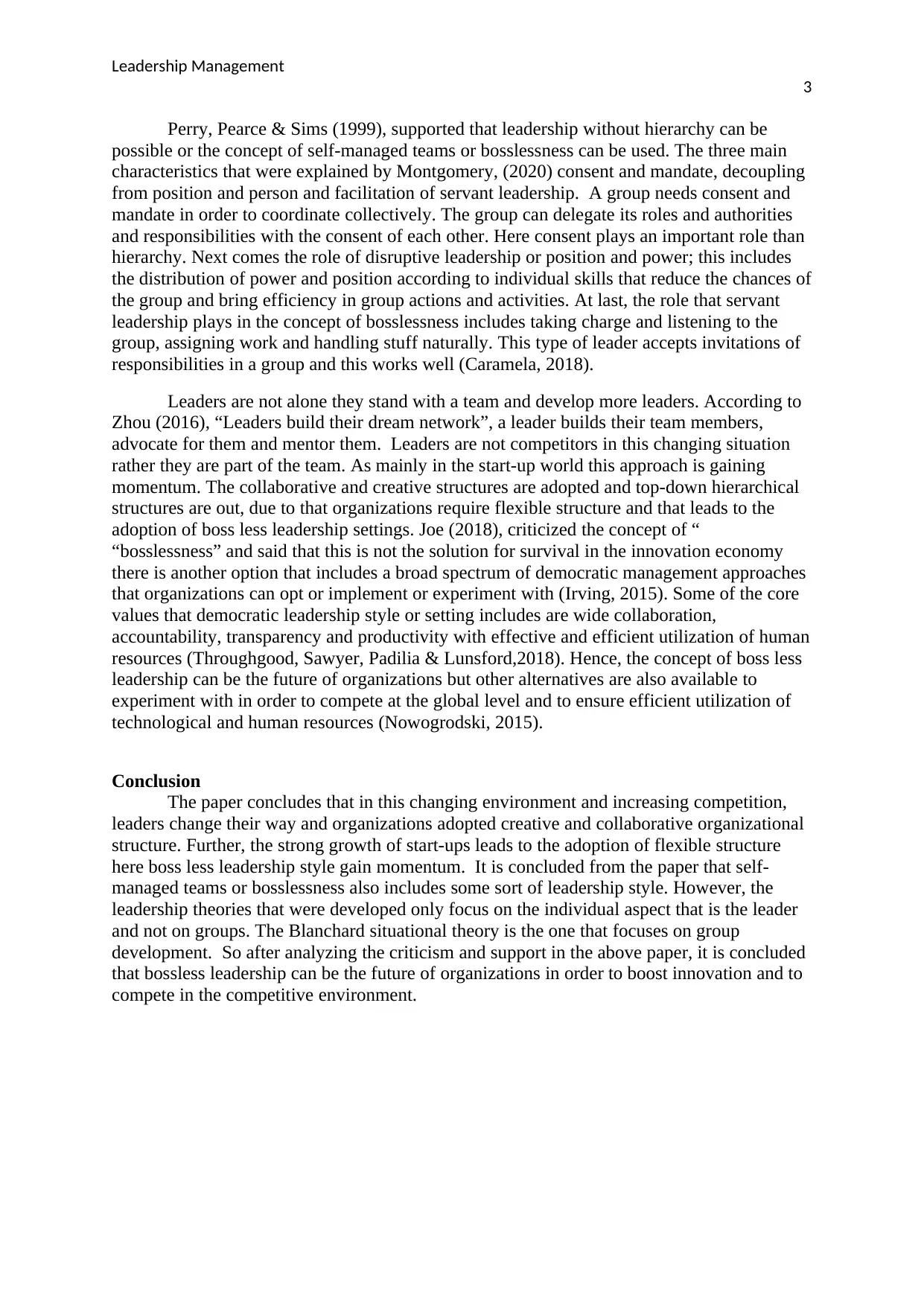
Leadership Management
3
Perry, Pearce & Sims (1999), supported that leadership without hierarchy can be
possible or the concept of self-managed teams or bosslessness can be used. The three main
characteristics that were explained by Montgomery, (2020) consent and mandate, decoupling
from position and person and facilitation of servant leadership. A group needs consent and
mandate in order to coordinate collectively. The group can delegate its roles and authorities
and responsibilities with the consent of each other. Here consent plays an important role than
hierarchy. Next comes the role of disruptive leadership or position and power; this includes
the distribution of power and position according to individual skills that reduce the chances of
the group and bring efficiency in group actions and activities. At last, the role that servant
leadership plays in the concept of bosslessness includes taking charge and listening to the
group, assigning work and handling stuff naturally. This type of leader accepts invitations of
responsibilities in a group and this works well (Caramela, 2018).
Leaders are not alone they stand with a team and develop more leaders. According to
Zhou (2016), “Leaders build their dream network”, a leader builds their team members,
advocate for them and mentor them. Leaders are not competitors in this changing situation
rather they are part of the team. As mainly in the start-up world this approach is gaining
momentum. The collaborative and creative structures are adopted and top-down hierarchical
structures are out, due to that organizations require flexible structure and that leads to the
adoption of boss less leadership settings. Joe (2018), criticized the concept of “
“bosslessness” and said that this is not the solution for survival in the innovation economy
there is another option that includes a broad spectrum of democratic management approaches
that organizations can opt or implement or experiment with (Irving, 2015). Some of the core
values that democratic leadership style or setting includes are wide collaboration,
accountability, transparency and productivity with effective and efficient utilization of human
resources (Throughgood, Sawyer, Padilia & Lunsford,2018). Hence, the concept of boss less
leadership can be the future of organizations but other alternatives are also available to
experiment with in order to compete at the global level and to ensure efficient utilization of
technological and human resources (Nowogrodski, 2015).
Conclusion
The paper concludes that in this changing environment and increasing competition,
leaders change their way and organizations adopted creative and collaborative organizational
structure. Further, the strong growth of start-ups leads to the adoption of flexible structure
here boss less leadership style gain momentum. It is concluded from the paper that self-
managed teams or bosslessness also includes some sort of leadership style. However, the
leadership theories that were developed only focus on the individual aspect that is the leader
and not on groups. The Blanchard situational theory is the one that focuses on group
development. So after analyzing the criticism and support in the above paper, it is concluded
that bossless leadership can be the future of organizations in order to boost innovation and to
compete in the competitive environment.
3
Perry, Pearce & Sims (1999), supported that leadership without hierarchy can be
possible or the concept of self-managed teams or bosslessness can be used. The three main
characteristics that were explained by Montgomery, (2020) consent and mandate, decoupling
from position and person and facilitation of servant leadership. A group needs consent and
mandate in order to coordinate collectively. The group can delegate its roles and authorities
and responsibilities with the consent of each other. Here consent plays an important role than
hierarchy. Next comes the role of disruptive leadership or position and power; this includes
the distribution of power and position according to individual skills that reduce the chances of
the group and bring efficiency in group actions and activities. At last, the role that servant
leadership plays in the concept of bosslessness includes taking charge and listening to the
group, assigning work and handling stuff naturally. This type of leader accepts invitations of
responsibilities in a group and this works well (Caramela, 2018).
Leaders are not alone they stand with a team and develop more leaders. According to
Zhou (2016), “Leaders build their dream network”, a leader builds their team members,
advocate for them and mentor them. Leaders are not competitors in this changing situation
rather they are part of the team. As mainly in the start-up world this approach is gaining
momentum. The collaborative and creative structures are adopted and top-down hierarchical
structures are out, due to that organizations require flexible structure and that leads to the
adoption of boss less leadership settings. Joe (2018), criticized the concept of “
“bosslessness” and said that this is not the solution for survival in the innovation economy
there is another option that includes a broad spectrum of democratic management approaches
that organizations can opt or implement or experiment with (Irving, 2015). Some of the core
values that democratic leadership style or setting includes are wide collaboration,
accountability, transparency and productivity with effective and efficient utilization of human
resources (Throughgood, Sawyer, Padilia & Lunsford,2018). Hence, the concept of boss less
leadership can be the future of organizations but other alternatives are also available to
experiment with in order to compete at the global level and to ensure efficient utilization of
technological and human resources (Nowogrodski, 2015).
Conclusion
The paper concludes that in this changing environment and increasing competition,
leaders change their way and organizations adopted creative and collaborative organizational
structure. Further, the strong growth of start-ups leads to the adoption of flexible structure
here boss less leadership style gain momentum. It is concluded from the paper that self-
managed teams or bosslessness also includes some sort of leadership style. However, the
leadership theories that were developed only focus on the individual aspect that is the leader
and not on groups. The Blanchard situational theory is the one that focuses on group
development. So after analyzing the criticism and support in the above paper, it is concluded
that bossless leadership can be the future of organizations in order to boost innovation and to
compete in the competitive environment.
Paraphrase This Document
Need a fresh take? Get an instant paraphrase of this document with our AI Paraphraser
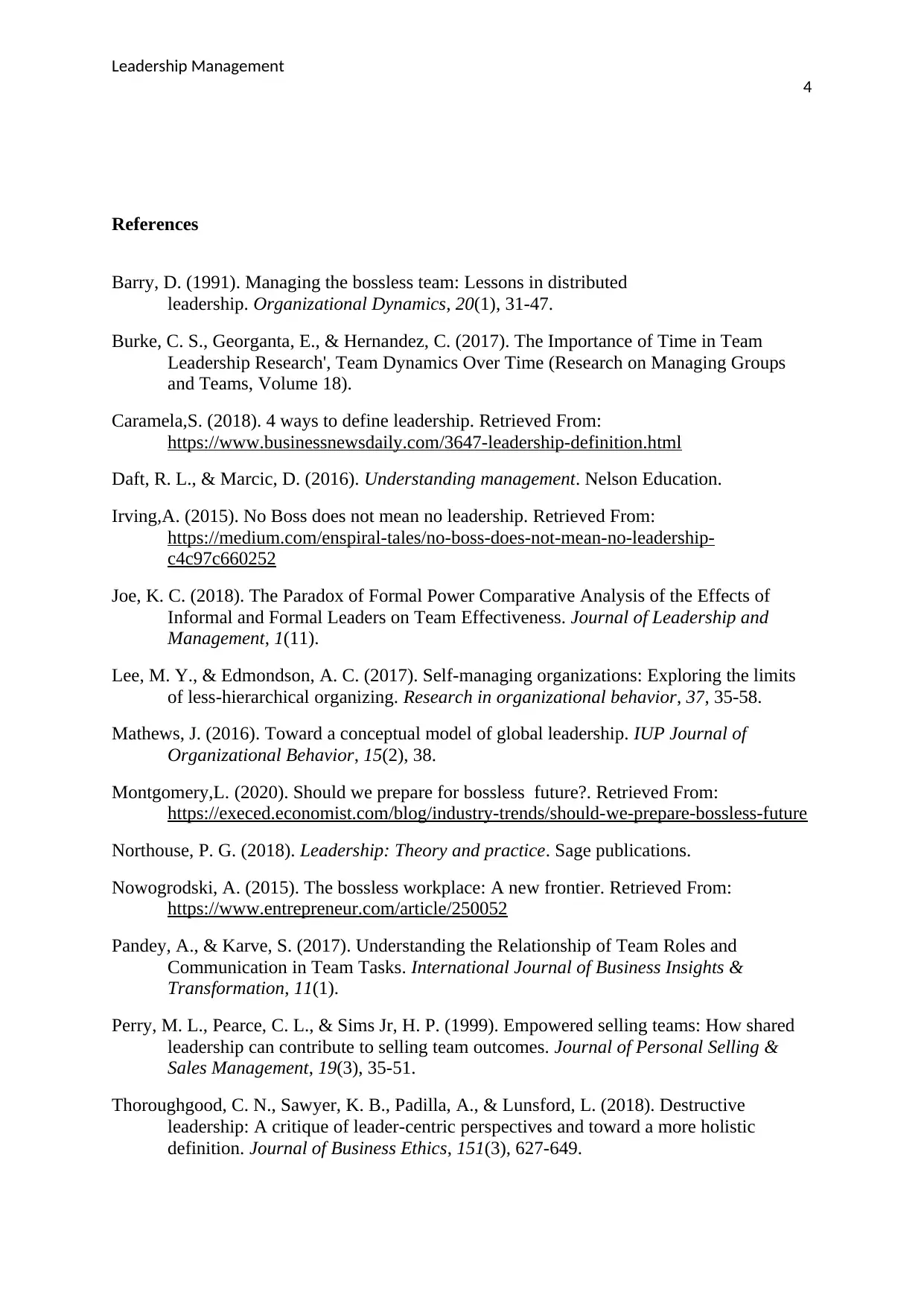
Leadership Management
4
References
Barry, D. (1991). Managing the bossless team: Lessons in distributed
leadership. Organizational Dynamics, 20(1), 31-47.
Burke, C. S., Georganta, E., & Hernandez, C. (2017). The Importance of Time in Team
Leadership Research', Team Dynamics Over Time (Research on Managing Groups
and Teams, Volume 18).
Caramela,S. (2018). 4 ways to define leadership. Retrieved From:
https://www.businessnewsdaily.com/3647-leadership-definition.html
Daft, R. L., & Marcic, D. (2016). Understanding management. Nelson Education.
Irving,A. (2015). No Boss does not mean no leadership. Retrieved From:
https://medium.com/enspiral-tales/no-boss-does-not-mean-no-leadership-
c4c97c660252
Joe, K. C. (2018). The Paradox of Formal Power Comparative Analysis of the Effects of
Informal and Formal Leaders on Team Effectiveness. Journal of Leadership and
Management, 1(11).
Lee, M. Y., & Edmondson, A. C. (2017). Self-managing organizations: Exploring the limits
of less-hierarchical organizing. Research in organizational behavior, 37, 35-58.
Mathews, J. (2016). Toward a conceptual model of global leadership. IUP Journal of
Organizational Behavior, 15(2), 38.
Montgomery,L. (2020). Should we prepare for bossless future?. Retrieved From:
https://execed.economist.com/blog/industry-trends/should-we-prepare-bossless-future
Northouse, P. G. (2018). Leadership: Theory and practice. Sage publications.
Nowogrodski, A. (2015). The bossless workplace: A new frontier. Retrieved From:
https://www.entrepreneur.com/article/250052
Pandey, A., & Karve, S. (2017). Understanding the Relationship of Team Roles and
Communication in Team Tasks. International Journal of Business Insights &
Transformation, 11(1).
Perry, M. L., Pearce, C. L., & Sims Jr, H. P. (1999). Empowered selling teams: How shared
leadership can contribute to selling team outcomes. Journal of Personal Selling &
Sales Management, 19(3), 35-51.
Thoroughgood, C. N., Sawyer, K. B., Padilla, A., & Lunsford, L. (2018). Destructive
leadership: A critique of leader-centric perspectives and toward a more holistic
definition. Journal of Business Ethics, 151(3), 627-649.
4
References
Barry, D. (1991). Managing the bossless team: Lessons in distributed
leadership. Organizational Dynamics, 20(1), 31-47.
Burke, C. S., Georganta, E., & Hernandez, C. (2017). The Importance of Time in Team
Leadership Research', Team Dynamics Over Time (Research on Managing Groups
and Teams, Volume 18).
Caramela,S. (2018). 4 ways to define leadership. Retrieved From:
https://www.businessnewsdaily.com/3647-leadership-definition.html
Daft, R. L., & Marcic, D. (2016). Understanding management. Nelson Education.
Irving,A. (2015). No Boss does not mean no leadership. Retrieved From:
https://medium.com/enspiral-tales/no-boss-does-not-mean-no-leadership-
c4c97c660252
Joe, K. C. (2018). The Paradox of Formal Power Comparative Analysis of the Effects of
Informal and Formal Leaders on Team Effectiveness. Journal of Leadership and
Management, 1(11).
Lee, M. Y., & Edmondson, A. C. (2017). Self-managing organizations: Exploring the limits
of less-hierarchical organizing. Research in organizational behavior, 37, 35-58.
Mathews, J. (2016). Toward a conceptual model of global leadership. IUP Journal of
Organizational Behavior, 15(2), 38.
Montgomery,L. (2020). Should we prepare for bossless future?. Retrieved From:
https://execed.economist.com/blog/industry-trends/should-we-prepare-bossless-future
Northouse, P. G. (2018). Leadership: Theory and practice. Sage publications.
Nowogrodski, A. (2015). The bossless workplace: A new frontier. Retrieved From:
https://www.entrepreneur.com/article/250052
Pandey, A., & Karve, S. (2017). Understanding the Relationship of Team Roles and
Communication in Team Tasks. International Journal of Business Insights &
Transformation, 11(1).
Perry, M. L., Pearce, C. L., & Sims Jr, H. P. (1999). Empowered selling teams: How shared
leadership can contribute to selling team outcomes. Journal of Personal Selling &
Sales Management, 19(3), 35-51.
Thoroughgood, C. N., Sawyer, K. B., Padilla, A., & Lunsford, L. (2018). Destructive
leadership: A critique of leader-centric perspectives and toward a more holistic
definition. Journal of Business Ethics, 151(3), 627-649.
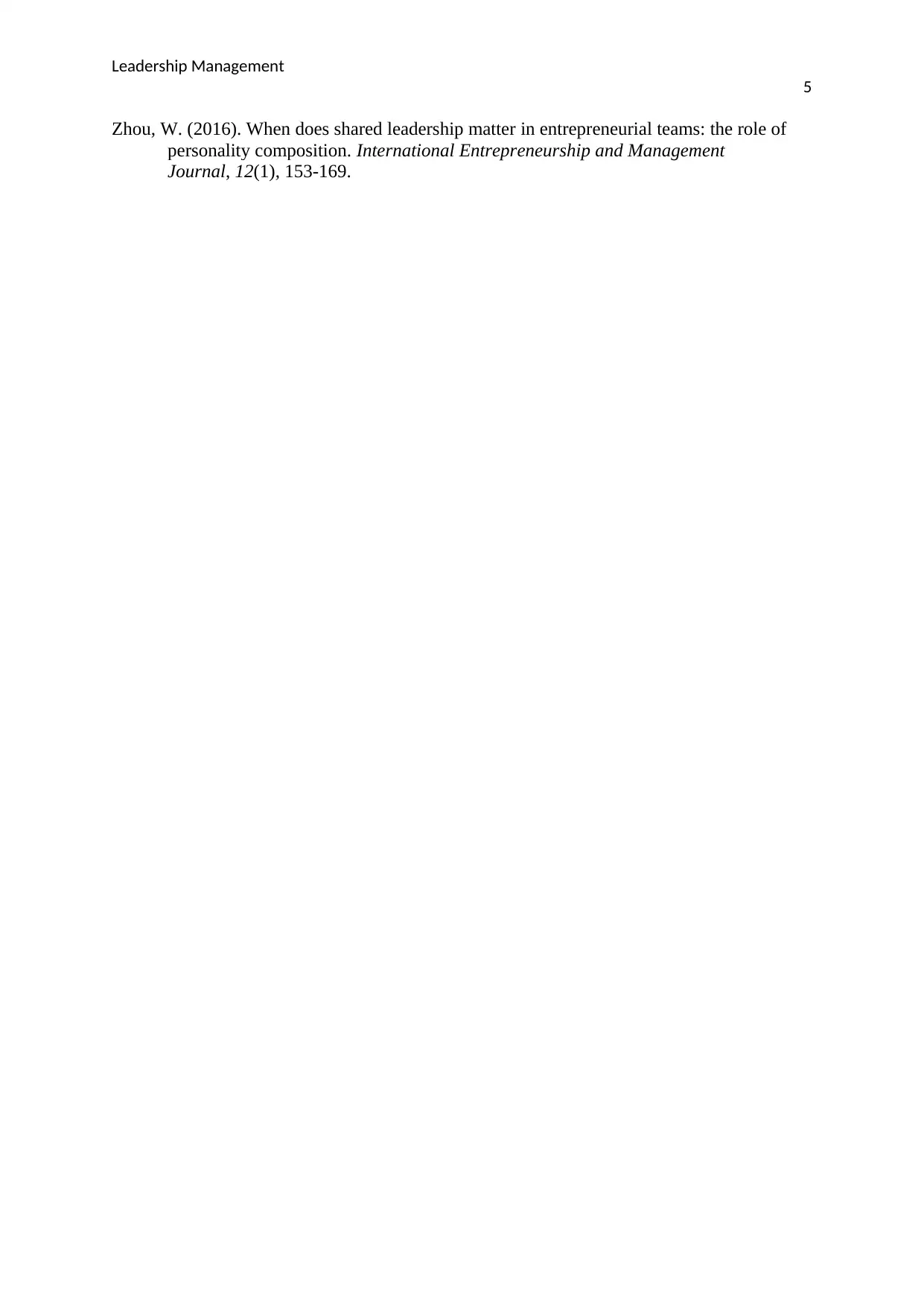
Leadership Management
5
Zhou, W. (2016). When does shared leadership matter in entrepreneurial teams: the role of
personality composition. International Entrepreneurship and Management
Journal, 12(1), 153-169.
5
Zhou, W. (2016). When does shared leadership matter in entrepreneurial teams: the role of
personality composition. International Entrepreneurship and Management
Journal, 12(1), 153-169.
⊘ This is a preview!⊘
Do you want full access?
Subscribe today to unlock all pages.

Trusted by 1+ million students worldwide
1 out of 6
Related Documents
Your All-in-One AI-Powered Toolkit for Academic Success.
+13062052269
info@desklib.com
Available 24*7 on WhatsApp / Email
![[object Object]](/_next/static/media/star-bottom.7253800d.svg)
Unlock your academic potential
Copyright © 2020–2025 A2Z Services. All Rights Reserved. Developed and managed by ZUCOL.





